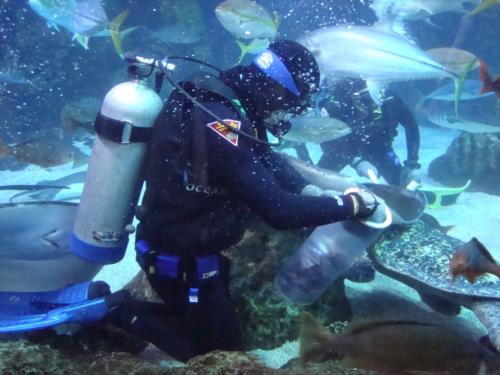 In which our hero embarks on the long wet road to Volunteer Diverhood at the Denver Downtown Aquarium. Part 2 of Several Installments.
In which our hero embarks on the long wet road to Volunteer Diverhood at the Denver Downtown Aquarium. Part 2 of Several Installments.Having proven my mettle in the Dining Room exhibit, I was now eligible to begin the DTAQ Diver Academy program, along with being committed to a minimum of two dives per month for a minimum of six months when I completed the course.
Diver Trainees are expected to start their training with dives in the smaller River tanks, before progressing to the larger and more difficult exhibits. I could wash out of the program at any time, if Brian or any of my instructors felt that I didn’t have what it took (for instance, freaking out when approached or touch by one of the larger residents, or while feeding them). The reality is that meeting up with an instructor for a given sequence of dives can be problematic, so Brian gave me the go ahead to begin my training in the Under the Sea tank w/ Dave R.
The Under the Sea exhibit (UTS) is one of the largest tanks in the Aquarium, and is easily the most interesting in terms of variety of life, landscaping, and features. There’s a transparent tunnel that the rays and shovelnose often glide up to and rest on top of, giving visitors walking through a great view of their underbellies. On one side of the tunnel is the larger portion of the tank, Sections 1, 2, and 3; on the far side is a narrow area (Section 4) favored by the two Nurse Sharks and the gigantic Potato Cod, as well as several crevices and holes for the smaller eels. Section 3 is the area in which our ‘Mystic Mermaids’ put on a show for the guests several times each day, the large curved wall acting as the front of their ‘stage.’
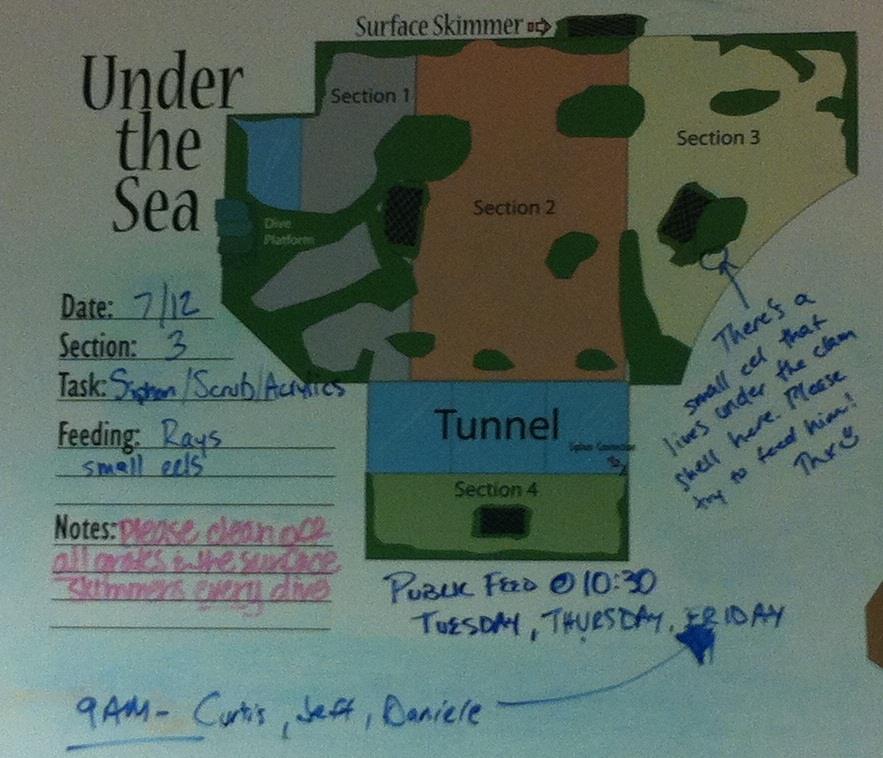
Training for Under the Sea consists of four dives. During the first I was oriented to the safety and emergency equipment and procedures, setting up/breaking down and priming the siphon, as well as feeding methods for the various critters. During each dive we spent time siphoning the bottom (using a 4’ long pipe to suck up debris from the gravel bottom, just like in a household aquarium), and scrubbing various surfaces in the section dictated by the Aquarists. Most of the resident fish are broadcast-fed by the Aquarists from the surface, but the various eels, turtles, rays and shovelnose need to be hand-fed by divers. That’s where the real fun begins.
The food for the rays and shovelnose is provided in a large (3’ long) plastic tube with drainage holes at one end, a rubber gasket at the other, and a rope handle in the middle. We can reach through the gasket to grab a piece of fish, then are supposed to hold it so it sticks out of our fist, either out the top between thumb and index, or out the side, between two fingers. The trick is to get it positioned in your hand, then out and down to the bottom before one of the fish darts in and grabs it (since the rays like to feed off the gravel).
When the rays see a diver settling down in the sand in front of the tunnel (we have to put on a show for the visitors of course), they’ve learned that food is on the way, and it’s like being mugged by a bunch of leather blankets.
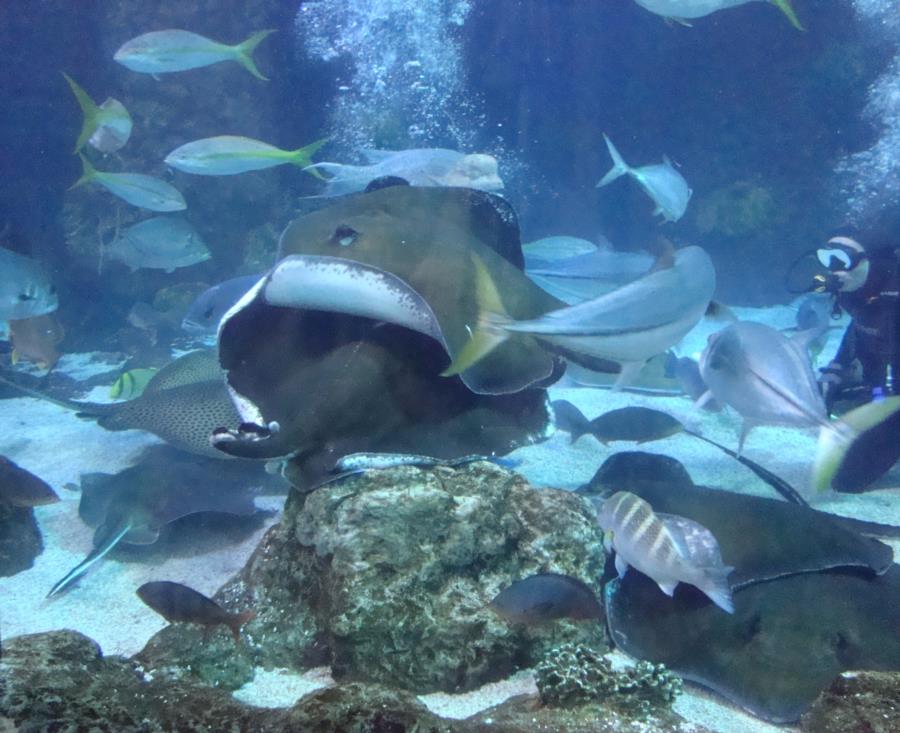
The beasties are everywhere you turn, sliding over you and your equipment, gliding in and out and anxious for food. If the turtles have finished their lettuce (heads of which we’ve set down with weights in other parts of the exhibit), they’ll swing in for a bite, and the shovelnose cruises through like a shark looking for prey. The crowd gets so rowdy they actually push us around the tank! Occasionally the rays or shovelnose will take a portion of our hand into their mouth, along with the food. Although our fingers are protected by both chainmail and a work glove, it’s still a bit of a pinch and you have to be willing to wait for them to figure out that what they’re chewing isn’t very nutritious before they’ll let go.
The shovelnose is very impatient and a tad aggressive – he’s been nicknamed ‘Sid Vicious’ by some – and he’ll circle around and dart in and try to steal the food you’re trying to give to the rays; if he doesn’t get what he wants he’ll swing around behind and nip the Feeder on the legs, arms, or shoulders. The Feeder’s buddy, the Tender, is supposed to protect the Feeder, using a PVC pipe in the shape of a ‘T’ to gently nudge and guide the little bugger away, but that’s not always possible, what with us being so ungainly in the water and the fish being totally nimble.
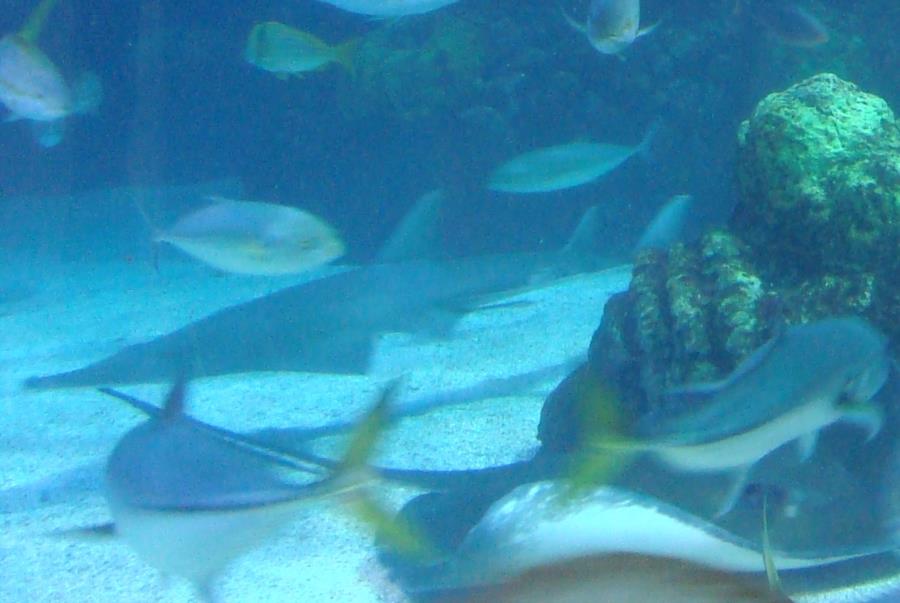
And even the rays get a bit impatient sometimes – I was often smothered by them sliding up and over my arms, shoulders and head, and was thankful that I was covered from head to toe in a wetsuit. Even so, I received a couple of minor hickeys on various limbs, and I was more than a little nervous when one of the larger Eagle Rays swam up and stopped with its mouth square on my crotch! But during my first feeding there were a couple that slid up and waited patiently in front of me as I kneeled on the sand, and even submitted to a little friendly scratching of their noses after I’d fed them.
When things get too hairy, we just swim up a few feet and wait for the beasties to calm down; it usually takes only a couple of minutes, then the rays disperse. When we settle back down on the sand, the hungriest ones show up first, and the rodeo starts again.
The two resident sea turtles (Donatello and Raphael) have learned that divers are good fun to hang with. The first time I was in UTS, I was floating at the surface about to speak to my instructor when suddenly one of them appeared directly in front of me and exhaled right in my face. Good thing I had my mask on; as it was I got a mouth full of turtle-breath! And when we’re feeding the eels it’s not unusual for them to grab at the velcro or the chainmail of our gloves with their beaks and try to get at the food we’re carrying.
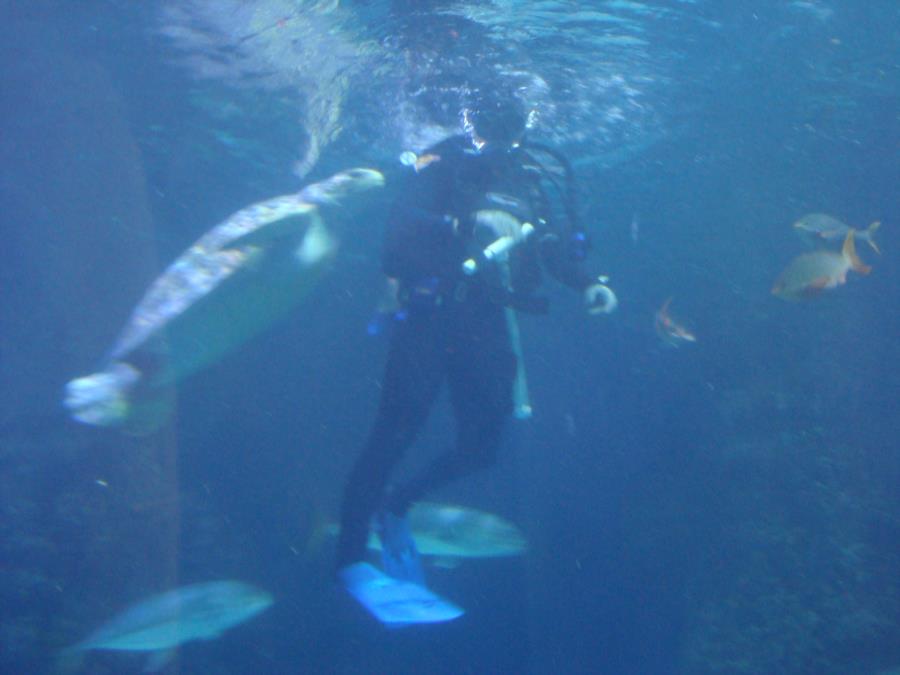
The first time I tried to feed the eels was like magic – and not in a good way. I had a pair of salad tongs, which I used to reach into a wide-mouth bottle full of little squid and other fish parts. The idea was to take out a piece of food and give it to one of the eels hiding among the faux rocks. Being used to recreational diving, I’ve learned to do things fairly slowly underwater. As I moved the food from the bottle to a crevice where an eel was waiting, the food suddenly disappeared. One moment it was there, the next it was simply gone! A fish had darted in and snatched it right out of the tongs so fast I didn’t even see it. I looked over at Dave, and saw a huge volume of air leaving his regulator as he laughed his butt off, both at what had happened and at my expression. He later told me it was very common, and he’d been expecting it – apparently it’s one of the pleasures of being a trainer!
One of my guilty pleasures while in UTS is ‘buddy breathing’ with the Potato Cod, a trick that Dave R showed me. The cod likes to hang out in Section 4, usually right along the glass. When I’m done scrubbing the tunnel glass (waving at the kids inside and posing for pictures all the while), I sidle up to the cod very slowly and offer it one of my regulators. I position the regulator under its jaw, then slowly dribble air out of it … it massages the cod’s mouth, and he slowly opens up and flares his gills wider and wider. Because of my position in front of the cod, I can see right down its gullet and out to the water and tunnel on the other side of the gills! The visitors love it: the first time I did it I was so focused on what I was doing, I was surprised by the number of flashes going off as people took photos.
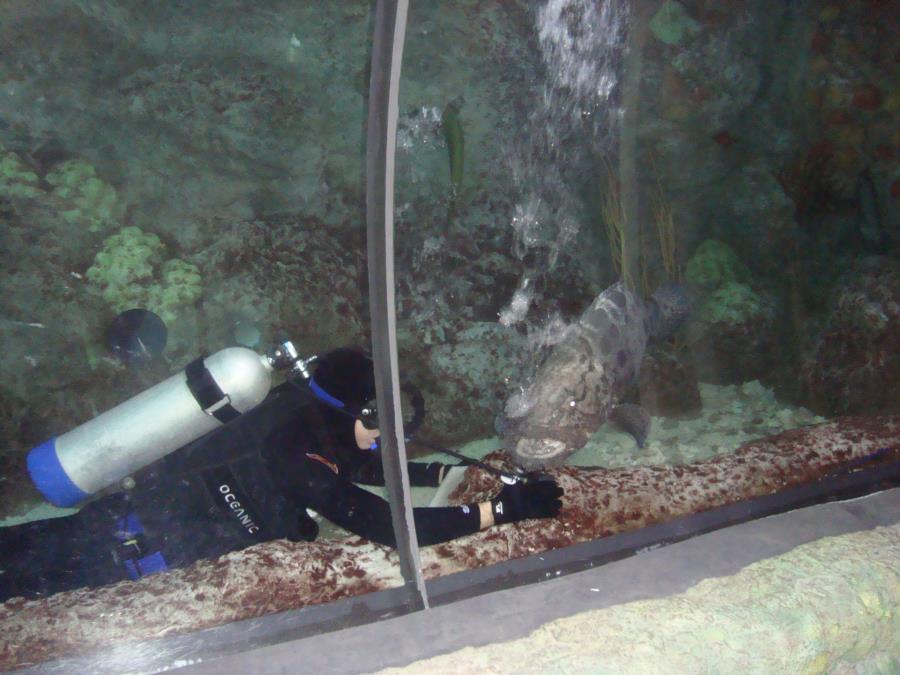 Dave Madorsky lives in the Denver Metropolitan Area; his personal philosophy is, “Anytime I’m underwater and still breathing is a GOOD time!”Please note: pictures were taken by and are copyright protected by Mira and Dave Madorsky.
Dave Madorsky lives in the Denver Metropolitan Area; his personal philosophy is, “Anytime I’m underwater and still breathing is a GOOD time!”Please note: pictures were taken by and are copyright protected by Mira and Dave Madorsky.